Home
A comprehensive resource for safe and responsible laser use
US: New Missouri law makes it illegal to aim a laser pointer at a uniformed officer
A "laser pointer" is defined as a device that emits a visible light amplified by the stimulated emission of radiation.
The offense is a Class A misdemeanor.
From the "Revisor of Missouri" website page describing the new law
US: Charges dropped against protester accused of laser pointer assault
Yusuf Labib had been arrested in March 2021 at a memorial for Breonna Taylor on a charge with "assault with force likely to cause great bodily injury."
At a court hearing, the prosecutor said "in this instance the People do not believe the evidence shows beyond a reasonable doubt that Mr. Labib specifically intended to cause fear of bodily harm.”
She continued, “The police officer in this case personally knew colleagues who have suffered permanent eye damage from lasers being shined in their eyes, so they take this conduct very seriously…. The People request Mr. Labib recognize that these potential risks exist before choosing to use a laser pointer in the future.”
Labib told the judge that he heard the prosecutor's comments.
From the Davis Vanguard
US: Air Force develops laser glare protection glasses for pilots
Washington State Patrol pilots successfully test special laser eye protection developed at Wright-Patterson Lab
Story by Mary Pacinda, Air Force Research Laboratory
Aiming a laser at an aircraft is a federal crime that can net offenders up to five years in jail or cost them a $250,000 fine. Even with this heavy potential penalty, laser strikes have become increasingly more common. According to the FAA, 6,852 such incidents were reported in 2020, compared with 385 in 2006, and so far this year, incidents of “joy lasing” are up 20 percent over last year. Cheap and easily obtained, hand-held lasers used as pointers and cat toys are certainly harmless when used as intended. But when they are aimed at the cockpit of an aircraft, they can temporarily blind the pilot — with possibly deadly consequences.
Laser strikes are almost always made at low altitudes when an aircraft is taking off or preparing to land — the two parts of flying that require the most attention from a pilot. Even if the beam of light does not hit the pilot’s eyes directly, it can cause a distraction or even raise an alarm that the plane may have become a target. In addition to the possible adverse effects of these human reactions, slight imperfections in the plane’s windscreen can cause the laser light to spread out, creating a glare that can temporarily obscure all vision inside the cockpit.
Of course, passing a law against any behavior — including pointing a laser at an airplane — seldom puts an end to the behavior. Thus, the best way to avoid disaster from laser strikes is to provide some sort of protection for the pilot. As a result, in recent years several manufacturers have developed laser eye protection (LEP) to meet a growing demand for help from military and law enforcement pilots. But this solution is not without problems of its own.
Most laser eye protection works by filtering out green or red light, the colors most commonly used in handheld lasers. Unfortunately, according to FAA studies and years of pilot experience, this can change the pilot’s ability to accurately read the instrument control panel. A 2019 FAA report suggested that this problem might be fixed by changing the type of lighting in the control panel.
Researchers at the Air Force Research Laboratory recently came up with a better solution, one that was successfully tested on the job by Washington State Patrol pilots.
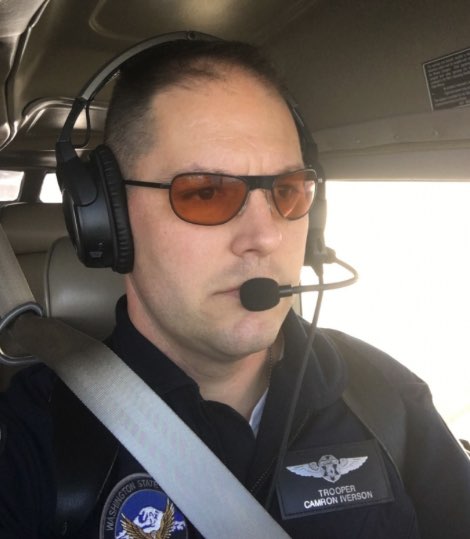
Flight Officer Camron Iverson of the Washington State Patrol tested laser protection lenses formulated at AFRL’s Materials and Manufacturing Directorate. (Photo by Mary Pacinda)
The Personnel Protection Team in AFRL’s Materials and Manufacturing Directorate, headed by Dr. Matthew Lange, used the cockpit compatibility design software developed for Department of Defense LEP and modified it for commercial use. The commercial version, called CALI (Commercial Aviation Low Intensity) filters out the laser light, but not the light coming from the pilot’s instrument panel. “Simply put,” said Lange, “the lenses maximize protection while minimizing the impact to the cockpit.”
US: Missouri bill proposes 1-year sentence for pointing laser at police
A number of persons representing doctors and police officers supported the bill. Even the lone person in opposition to the bill supported the general idea but thought that the penalty was too harsh.
On March 2 2021, the Standing Committee on Public Safety in executive session voted 10 to 0 in favor of the bill. It was referred to the Rules - Legislative Oversight committee for further action.
Bill text at the Missouri House of Representatives 101st General Assembly HB 31 webpage. Story from the News & Record, though it is difficult to tell whether the bill described in the story is this one or is HB280 which does not appear to include laser misuse in its text.
US: Arizona law proposes stronger penalty for laser misuse during disorderly protests
Currently, this offense is a Class 1 misdemeanor. House Bill 2309, if passed, would make this a Class 6 felony if the "offense occurs in the course of committing violent or disorderly assembly."
A Class 6 felony is considered aggravated assault, with a mandatory minimum six month jail term.
"Violent or disorderly assembly" is a new term created in the bill, defined as follows: "A person commits violent or disorderly assembly if, with seven or more other persons acting together, the person, with the intent to engage in conduct constituting a riot or an unlawful assembly, causes damage to property or injury to another person."
As of February 24 2021, the bill was reported out of committee to the House.
From the Martinsville Bulletin
US: Los Angeles bans lasers from demonstrations
At an October 27 2020 public meeting, the deputy chief of the L.A. Police Department, said "… we have experienced numerous instances of individuals among these groups intentionally using laser devices and pointers to attempt to blind and cause harm to officers by pointing them purposely at their eyes…. Laser-type devices have no legitimate use outside of the business or educational venues."
The department warned officers to "adjust their vision" to avoid laser beams, and "has since sought to use eyewear and screens" to protect eyes from laser light.
An LAPD spokesperson said thus far in 2020, there had been 20 incidents of laser pointers being used to blind or distract people. Twenty-four people reported eye damage during the incidents, according to the spokesperson. Twenty of them were police officers; some were driving at the time.
The Los Angeles Times reported "In July, LAPD Officer Kyle Rice lost his vision in his right eye, as well as his ability to balance, and was left with migraine-like headaches after he was targeted with a laser pointer after responding to a radio call of a disturbance in Little Tokyo. A person not involved in the dispute between an homeless person and a business owner is accused of pointing the laser at Rice’s eye. An arrest was made in the incident."
According to the L.A. Sentinel, "Some people who spoke during the meeting said it was ironic that the LAPD was asking for a laser-pointer ban at protests, as officers have been photographed using bean bag projectiles that have allegedly caused gruesome injuries to some protesters, such as lost eyeballs and teeth."
Section 55.07 also prohibits items such as wood, pipe, hard signs, baseball bats, aerosol spray (tear gas, mace, pepper spray), firearms, BB guns, tasers, knives, glass bottles, open flame torches, shields of metal, wood or hard plastic, bricks, and rocks.
From the Los Angeles Times, and from the City News Service via the L.A. Sentinel and NBC Los Angeles. More on officer Kyle Rice is here.
US: Report describes 12 severe eye injuries during late May 2020 protests (not a laser)
According to the Post, "in three instances, video evidence undermines official accounts of what happened." The report said four additional people were also partially blinded by police during the week that included May 30.
From the Washington Post
Note: This story is part of our occasional coverage of eye injuries at protests which were not caused by a laser. This is because the number of actual or claimed laser eye injuries at protests (generally inflicted on police or security forces) is vastly outnumbered by actual or claimed eye injuries to protesters, journalists and bystanders (generally caused by police or security forces). In our view, no one should aim a laser or projectile at anyone's eye or head during protests, demonstrations and civil unrest.
US: Ophthalmologists cite 20 eye injuries from U.S. protests (not a laser)
- 7 persons lost an eye, "with additional patients undergoing surgery to save their eye"
- Persons who lost an eye ranged in age from 21 to 37 years
- Persons with an eye injury ranged in age from 16 to 59 years
- Injuries were caused by rubber bullets, bean bag rounds, pepper balls, a tear gas canister, and a corneal injury from a taser.
In addition, the AAO press release had links to stories about eye injuries during protests in Kashmir, Chile and Hong Kong.
On June 3 2020, AAO issued a statement condemning rubber bullet usage, and giving tips on eye protection from projectiles and from tear gas. They noted that tear gas "typically doesn’t cause irreversible eye injuries, but tear gas has caused serious eye injuries, including hyphema, uveitis, necrotizing keratitis, coagulative necrosis, symblepharon, secondary glaucoma, cataracts and traumatic optic neuropathy and loss of sight."
A day later AAO provided information, social media handles, photos and graphics in a post called "Help Us Stop Rubber Bullets Before They Blind More People."
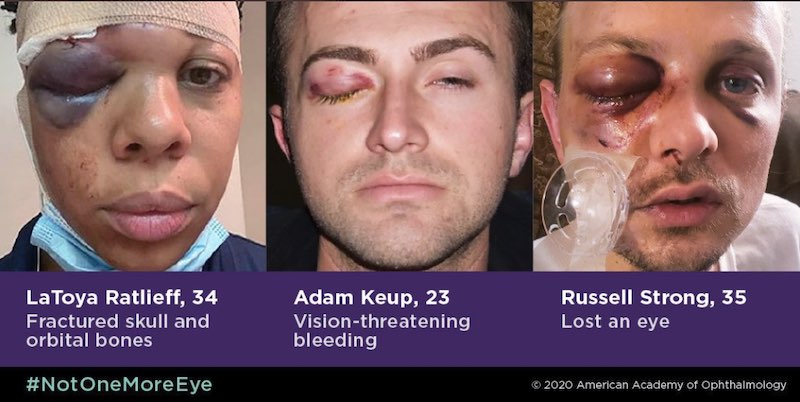
Graphic tweeted by AAO
Note: This story is part of our occasional coverage of eye injuries at protests which were not caused by a laser. This is because the number of actual or claimed laser eye injuries at protests (generally inflicted on police or security forces) is vastly outnumbered by actual or claimed eye injuries to protesters, journalists and bystanders (generally caused by police or security forces). In our view, no one should aim a laser or projectile at anyone's eye or head during protests, demonstrations and civil unrest.
UK: Home Secretary wants more power for police to search for laser pointers
Javid will open a public consultation to extend the power of "reasonable grounds" (to search suspects). Proposed changes will go before Parliament.
From September 4 2018 articles in The Times and The Sun
UK: Professor develops laser-absorbing strip for police face shields; "several thousand" used in Northern Ireland
The strip was developed by John Tyrer of Loughborough University, professor of optical instrumentation. He was commissioned by the Home Office and the PSNI who were concerned about increasing numbers of demonstrators aiming laser pens at police.
The light distracts officers and breaks their positions, according to Tyrer. The orange-tinted film is low-cost and simple to apply.
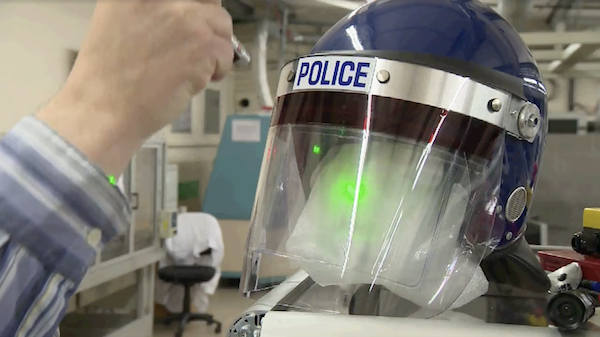
Tyrer demonstrates how light from a laser pen goes through the clear part of the face visor, causing glare and potential eye injury to an officer.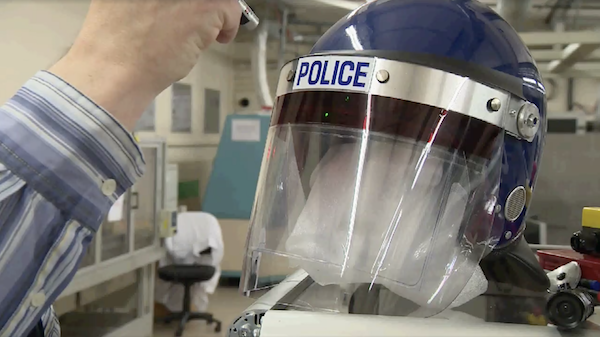
But if the officer tilts his or her head down so the laser goes through the strip, laser light is absorbed and does not present a hazard.
Testing by Public Health England, and real-life usage in Northern Ireland, showed the anti-laser strip to be “very effective”.
Tyrer has also suggested that the same film applied to glasses can protect pilots during takeoffs and landings from any laser activity that might be occurring.
From the Loughborough News Blog and Police Oracle
UPDATE JULY 27 2020: The visor strips are sold by Laser Optical Engineering Ltd. in the U.K. Pricing is £25 (USD $32) per strip in low quantities (<200). According to LOE, in field use it was found that direct attacks on police "stopped quickly" once protesters knew their lasers were ineffective and that laser attackers would be identified and arrested. LOE also sells anti-dazzle glasses. Pricing is £50 (USD $64) each in low quantities (<50).
Additional information about laser use and mis-use at protests, and ways to protect eyes is on the Laser use during protests page.
UK: NPAS says only 1.4% of laser perpetrators were prosecuted
James Cunningham told Police Oracle in a March 21 2018 article that there were a number of reasons for the low prosecution rate, including being not being able to follow the laser perpetrator due to being focused on another job (e.g., completing the original mission).
Also, when lasers are pointed from a tower block area, the helicopter crew may not be able to locate the source.
In 2017 there were 67 incidents [not clear if this is NPAS only], compared with 70 in 2016 and 103 in 2015. Cunningham said the reduction is because NPAS is trying to locate and pursue laser perpetrators, and report the incidents as crime. He said the Laser Misuse (Vehicles) Bill being considered in Parliament is a “step in the right” direction that could lead to more prosecutions.
In December 2017, NPAS purchased laser-reducing glasses which can enable pilots to continue even when illuminated by laser light.
From Police Oracle
US: Airport police can go off property to find laser attackers
The measure aims to address people pointing lasers at planes that are taking off or landing and the proliferation of drones near airports. It was signed Tuesday November 22 2016 by Gov. Rick Snyder.
The lasers often are used off airport property but directed at planes while in protected airspace. The beams can fill cockpits with green light and temporarily blind pilots or blur their vision.
From the Detroit Free Press, November 23 2016.
Note from LaserPointerSafety.com: We have been unable to find details about this law. For example, a search of the Michigan Legislature website for bills introduced in 2015-2016 with “laser” as a keyword did not appear to turn up any relevant text. For example, adding “airport” as a search term found no bills at all. A similar search for completed signed bills (“Public Acts”) found a list only with entries prior to August 2016. If anyone has more details about this bill, please contact us.
UK: Statistics on police helicopter laser attacks; one has been struck 100 times "over the last year"
Assuming “over the past year” means “in the last 12 months”, that would be an average of about two laser illuminations per week.
A separate article from BBC News states that in 2015 there were 91 reported laser illuminations of National Police Air Service aircraft. The largest number was 20 attacks against NPAS helicopters taking off from its Carr Gate headquarters near Wakefield, West Yorkshire.”
Reasons for the apparent discrepancy in numbers are not clear. It may be that South Yorkshire is not a member of the NPAS, which provides centralized air support to local police forces.
The BBC News chart below shows the 2015 NPAS laser attacks:
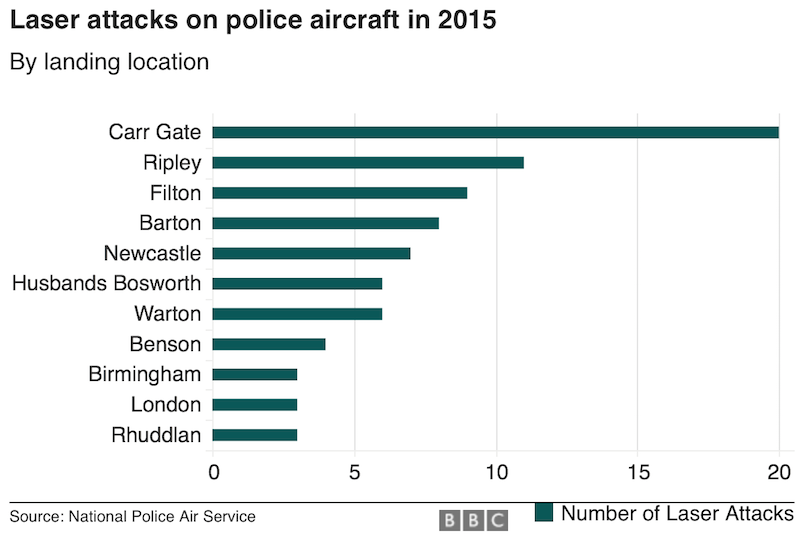
The NPAS is testing laser protective eyewear, as a means to help protect flight crews.
From The Star and BBC News. Interestingly, a September 14 search of the South Yorkshire Police website, to find more information about these incidents and police concern regarding lasers, did not find any results when searching for the term “laser.”
UK: Police get advice from U.S. FBI on stopping U.K. laser incidents
While both the U.S. and the U.K. have laws with penalties up to five years in jail, in the States jail sentences have been imposed while fines are the norm in Britain. The U.S. also has a centralized national reporting system, which the British officials seek to emulate.
Mark Callaghan, an NPT inspector for Sussex Police, told the Express about a case in April 2014 where a laser beam was aimed at an Airbus A319 from a Travelodge near Gatwick Airport. The pilots reported that “The green laser was extremely aggressive and we suffered three or four two-second attacks directly into the cockpit causing blotchy vision, squinting, broken concentration, sore eyes.” The perpetrators were not caught.
Callaghan noted “We can find out who was in the rooms but we have no power to conduct any searches and even if there were lasers there what evidence is there to say they did it? We would like some preventative legislation. The US have got it nailed on how they deal with this.”
From the Express
UK: 107 laser pens seized from house near Southampton Airport
In the ten weeks prior to September 26 2014, there were seven incidents of lasers being pointed at aircraft; five of these led to arrests.
News reports did not directly link the misuse to the man arrested with the 107 laser pens. It also is not known if the investigation that led to the seizure was started in response to the aircraft incidents, or was separately initiated. All flights landed safely.
One of the seized pens was said to be 650 times more powerful than normal. Given that U.K. regulations prohibit laser pointers above 1 mW, the pen was likely 650 milliwatts. This is Class 4, the most hazardous laser classification, as the beam can cause eye and even skin burns.
From the Daily Echo
Arizona: Pilots will seek to upgrade laser pointing penalty to felony
The first draft of the April 2014 law called for a Class Five felony to “knowingly or intentionally” aim a laser towards an aircraft. But there was concern among legislators that juveniles could end up with a felony record. The bill passed once the penalty was reduced to a Class One misdemeanor.
In a September 22 2014 story, reporter Emilie Eaton recounted Arizona’s experience. FAA-reported incidents in the state rose from 138 in 2010, to 202 in 2013. One police pilot interviewed said that he had been hit by lasers over 100 times, during a 22 year career. The pilot, Chris Potter, said he had permanent damage from a laser strike: “It literally felt like I got punched in my eye and there was a piece of debris, like a piece of glass in my eye.”
Another pilot quoted, Pima County Sheriff’s Department deputy Chris Janes, said he has has between 12 and 24 laser strikes from 2007 to 2014: “I have not received any eye damage. But I’ve had headaches afterward. I’ve had eye discomfort for several days afterward.”
From Cronkite News, via the Tucson Sentinel
UK: 1300+ laser incidents in 2013
The newspaper also reported that in the 12 months between October 2012 and September 2013, there were 31 reports of aircraft being illuminated as they approached Gatwick Airport, 30 miles south of London.
Laser strikes have also increased on rescue helicopters flying out of Redhill Aerodrome, Surrey, a few miles north of Gatwick. A tactical flight officer was quoted as saying “I've had to break away from a task because of being lasered and it's not because we're trying to catch a bad guy, it's because we're trying to find people potentially in danger.... There are certain elements of society that might be trying to harm us or put us off being in a certain location.”
Police inspector Mark Callaghan told the Mirror that there have been a number of jail terms for perpetrators, but that "Hand-held lasers are easily obtained over the internet or from market stalls and street vendors abroad. The warning labels on these are misleading and they are more powerful than advertised."
From the Surrey Mirror
US: Puerto Rico law makes pointing lasers at aircraft or law enforcement illegal
In addition, if the laser pointing results in serious bodily harm to a human being (defined as “an injury that requires hospitalization, long-term treatment, or causes permanent or mutilating injuries”), the violation becomes a felony.
As of August 14 2014, it is not known if the act has been signed by the Governor, and thus whether it has become an official law. [Usually, such laws are signed by the executive. However, in October 2013, New Jersey Governor Chris Christie vetoed a law, passed by the legislature, that would have banned the sale of laser pointers over 1 milliwatt.]
From a PDF of S.B. 799. The text of the law is here. Thanks to George Johnson for bringing this to our attention.
Switzerland: After laser pointer attacks, first responders will have laser protective eyewear
After tests in mid-2013, the Basil Justice and Security Department purchased 1,000 pairs of laser protective eyewear, at 200 Swiss Francs each (USD $224).
All Basel police officers and rescue emergency vehicles are equipped with the glasses, as of December 2013. Other Swiss cantons are in the testing phase.
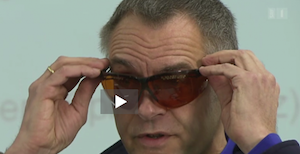
The Basel anti-laser glasses are demonstrated in this frame from a SRF video.
From a December 16 2013 report by Schweizer Radio und Fernsehen, (original German text and Google-translated into English). Thanks to Basel officer Ruedi Maier for bringing this to our attention. For additional news items from Switzerland, including the 2011 purchase of laser protective eyewear for air rescue helicopter pilots, click here.
US: NIST working to get forensics labs to measure laser pointers for court cases
The effort began when NIST physicist and laser safety officer Joshua Hadler worked with the U.S. Attorney’s office on a 2013 case in Fresno, California. Hadler already had devised a relatively simple and inexpensive way to accurately measure laser pointer powers. (His widely-reported study showed that a majority of pointers exceeded the U.S. limit of 5 milliwatts.)
But power is only one factor of the potential laser hazard. The beam spread, or divergence is another key factor. This is because a wide, high-divergence beam will have its energy spread out more, making it dimmer and less hazardous at a distance than an otherwise equivalent-power laser with a narrower, low-divergence beam.
To tackle this, Hadler used a pyroelectric laser camera to measure the laser’s divergence. From the power and divergence, and knowing the approximate distance to the aircraft from the Federal Aviation Administration incident reports, Hadler was able to calculate the irradiance, or laser power over a given area.
The information helped to get a conviction in the Fresno case. Hadler noted that in the past, “...the vast majority of prosecutions were failing, due in no small part to a basic lack of knowledge about the laser devices on the part of nearly everyone in the trial process, including lawyers, judges, and jury members. What they needed was to be able to acquire and present quantitative data about a device's power and its effects at a specified range that could be used in the judicial process."
Hadler will present a paper on February 21 2014 at the American Academy of Forensic Sciences meeting in Seattle, Washington. The paper, “Output Characterization of Handheld Lasers Used in Criminal Aircraft Illumination,” will discuss the needed measurements and will present ideas for having these measurements be done outside of NIST, in law enforcement forensic labs.
From PhysOrg
US: UPDATED - Arizona bill to make aiming a laser at aircraft a felony
The Tucson Police Department had about 50 lasing incidents in 2013; the perpetrator was caught in most of the cases. But there was little prosecution.
Orr says the bill is needed because “there’s really no punishment. The county prosecutor, because it's not at a felony status, doesn't go after them. And so literally, you get a ticket and nothing happens. But you're endangering lives."
Orr is working with Tucson police pilot Chris Potter, who says he has been hit by a laser pointer about 100 times in his career. Potter says a laser pointer permanently damaged his right eye around 2011.
According to News 4 Tucson, “the FBI will launch a public awareness campaign about the issue next month.” It was not clear if this was an Arizona-area initiative or nationwide.
From News 4 Tucson
UPDATED - February 4 2014: The Arizona House Judiciary Committee voted in favor of increasing the penalty for persons who point lasers at aircraft. HB 2164 would make it a Class 5 felony, with a presumptive sentence of 18 months in prison, to knowingly or intentionally point a laser at an occupied aircraft. And the penalty would go to 30 months if the act disables the pilot or causes serious physical injury to anyone on board. The legislator who introduced the bill, Ethan Orr, is considering reducing the penalty slightly, to a Class 6 felony, when it goes to the full House. Prosecutors could reduce the charge from a felony to a misdemeanor when appropriate. Orr said this might be the case for youths so that a single mistake would not result in a felony record. From KWST.com. A related article at AZCentral.com includes comments from LaserPointerSafety.com’s Patrick Murphy on the issue.
UPDATE 2 - May 1 2014: The bill was eventually amended to make the act of aiming at an aircraft a Class 1 misdemeanor. The act became an assault if the pilot was unable to safely operate the aircraft or if anyone onboard suffered a serious physical injury. The amended version passed both legislative bodies and was sent to Governor Jan Brewer, who signed it on April 30 2014. From the Arizona State Legislature legislative history of HB2164.
UPDATE 3 - September 23 2014: The Arizona Police Association and other law enforcement groups want to increase the penalty to a felony. They hope to introduce a measure when the legislature re-convenes in January 2015.
US: Tucson police pilot says he has permanent retinal damage from laser exposure
The statement came as hundreds of Arizona law enforcement pilots attended a safety seminar in Tucson focusing on laser beam incidents. In 2012 in Tucson alone, the police department’s air unit had “close to 50 incidents”, according to Potter. As of November 2013, Phoenix was the top U.S. city for laser incidents.
From KVOA News
US: FBI uses sophisticated surveillance to catch Portland man who lased ~25 aircraft
The operation was initiated in August 2013, after multiple incidents of lasers being aimed at aircraft around Portland International Airport. Four law enforcement aircraft were equipped with video surveillance cameras.
On August 10, five aircraft were targeted by a ground-based green laser. One was an Alaska Airlines flight; two were from the FBI and two were from the Portland Police Bureau. At the same time, a surveillance team was on the ground. Using information from the FBI/PBB aircraft sightings, the ground officers observed suspicious behavior from a male in the back yard of a duplex apartment. He was looking up at the sky. He removed something mounted from a stand or pole, and went inside. The laser strikes ceased afterwards.
Six days later, after reviewing the video, consulting Google Earth and Google Maps, and visiting the apartment complex, an FBI Special Agent determined that Apartment 35 -- the one previously surveilled -- was the most likely source of the laser. The apartment was occupied by 39-year-old Stephen Francis Bukucs.
Surveillance cameras were then secretly installed, watching Apartment 35. They could see in daylight, low light and nighttime (using infrared).
Click to read more...
Switzerland: Police want higher power laser pointers classed as weapons
Since 2011, laser pointers above 5 milliwatts are prohibited in Switzerland. The Swiss Federal Office of Public Health is working on proposals to classify laser pointers as weapons and will present these by 2014.
From 20 Minuten (original German text and Google-translated into English)
Canada: Laser strikes up significantly in Edmonton
A police pilot spokesperson said laser users are not reading the packaging which clearly states not to aim at aircraft. After being caught, "There's been a lot of apologies, a lot of regret, some people not realizing the consequences of what they were doing, and then there's been the far opposite -- I can't believe this is happening, this is ludicrous, this isn't serious, it's just a laser pointer."
The pilot also said that a ban is not the answer: "If it's used properly, it's harmless. It's hard to ban something like that, the sale of it completely if 95% of the general public are using it properly."
He noted that not just police aircraft are being lased. Commercial and private aircraft also are at risk.
Edmonton police helicopter pilots are equipped with safety glasses for use during laser illuminations. They have two pair, one to attenuate red laser light and one to attenuate green laser light.
For details on the two most recent Edmonton incidents, on September 6 and 7 2012, see this LaserPointerSafety.com story.
From the Edmonton Journal and Edmonton Sun. Thanks to Keith Murland for bringing this to our attention.
US: L.A. Sheriff's Dept. puts "Laser Strike" info video on YouTube
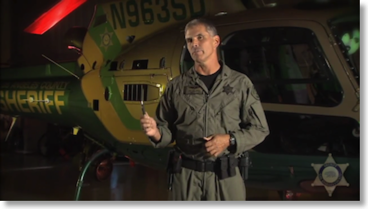
To see the video, click this link to YouTube. Following this link should also lead to the bonus content videos.
To get a flavor of the training video, click the “Read More…” link below for a list of selected excerpts and interesting statements.
US: 198 calls to police about lasers in 3 months; Coast Guard "cracking down" in Myrtle Beach
The local Coast Guard echoes the concerns. Twice in two weeks, search and rescue missions were ended prematurely because of lasers being aimed at helicopters. (See a report here.) Under Coast Guard regulations, after laser exposure the aircraft is grounded and the pilots are medically evaluated before being allowed to fly again.
The Coast Guard issued a letter asking the public to stop aiming at aircraft, and saying that they want to enforce South Carolina’s state law against lading aircraft. The letter is reprinted below (click the “Read More” link).
From WMBF News. This is part of continuing stories at LaserPointerSafety.com about ongoing problems at Myrtle Beach.
Click to read more...
Canada: RCMP purchases anti-laser glasses
From Vertical magazine
Click to read more...
US: Georgia bill would ban aiming at police and aircraft
The proposed bill would 1) establish the offense of unlawful pointing of a laser device at a law enforcement officer, and 2) prohibit aiming a laser pointer or projecting a laser on or at an aircraft or the flight path of an aircraft. The legislative history of the bill, including the full text of the Senate and House versions, is at the Georgia General Assembly website. We have also put the full text of the House version on the U.S. laws page here at LaserPointerSafety.com.
One interesting point is that the bill contains an exemption for “laser or laser pointer airspace uses that have been reviewed and approved by the Federal Aviation Administration.” This is a broader provision than the recently passed U.S. law, which only permits certain FAA-reviewed uses such as research and development.
In the view of LaserPointerSafety.com, the Georgia bill’s language is more flexible and still maintains safety, since they leave it up to the FAA to determine what outdoor laser uses are approved (technically, “non-objected”).
General interest: Article discusses pros and cons of laser sights for weapons
Author John Wills notes that laser sights are not as effective beyond 20 feet, and they do not substitute for marksmanship techniques such as grip and stance.
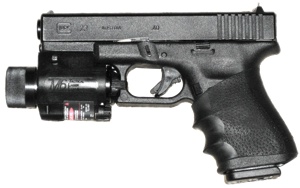
Glock Model 23 with M6 Tactical Laser Illuminator (xenon light plus red laser pointer < 5 mW).
Image from nukeit1 at Flickr, CC by 2.0 license.
Green laser sights are now available; they are more easily seen than an equivalent-power red laser. Infrared laser sights are made for use with night vision goggles. The beam cannot be seen by the naked eye, so a bad guy does not even know he is being targeted.
Wills concludes by saying “like any other tool there is a right way and a wrong way to use” lasers.
From Officer.com
US: Tampa police purchase anti-laser filters for night vision goggles
A person wearing NVGs is normally not at risk of retinal injuries, since direct laser light falls on the image intensifier device and not the eyes. (Depending on the NVG mounting style, it may be possible for direct laser light to enter from the side or from parts of the vision not covered by the NVG optics.) However, a serious concern is with laser light causing “blooming” of the night vision enhanced image, or even damaging the NVG sensor. To help prevent this, Night Flight Concepts developed “Laser Armor” Light Interference Filters.
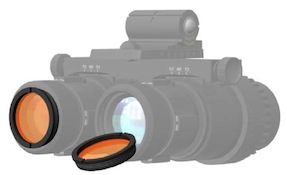
Company consultant Dr. Dudley Crosson says the screw-in filters “allow the goggles to function normally by reducing the blooming effect significantly.” A Laser Armor product sheet says the filters reduce blue (445-450 nm) intensity by 97%, and reduce green (532 nm) intensity by 99.5%.
From Aviation Today and a Night Flight Concepts press release
UK: Police dazzler laser being tested to flashblind rioters
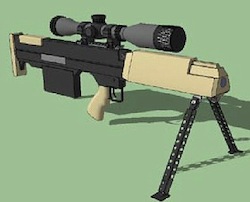
Concept of the rifle, from the Daily Mail
The developer is Photonic Security Systems, which also markets the rifle as a pirate deterrent. The Telegraph says that similar devices have been used in Afghanistan by NATO-led International Security Assistance Force troops.
PSS managing director Paul Kerr told the International Business Times "The very purpose of this technology is to be non-damaging … If someone is prepared to just stand there and stare down the barrel at this, which would be incredibly uncomfortable, then they are definitely a threat.” He said that he has often been exposed to the laser: "The quality and safety of the device is paramount and I know that first hand because I have been the guinea pig many times. I know what it is like and I know how effective it can be."
Author and activist Cory Doctorow points out that “the UK is a signatory on the Protocol on Blinding Laser Weapons … this weapon wouldn’t run afoul of international law if it (merely) reduced your vision to the point where you were impaired but not legally blind, permanently.” Doctorow also says “Twitter wags are already predicting a resurgence of mirrorshades [reflective sunglasses] among protesters.”
From the Telegraph, the Daily Mail, the International Business Times and BoingBoing. See related story on BAE Systems anti-pirate dazzler.
.
US: 3 sheriff's officers charged with illegal laser sales
92 laser sights and 74 automatic machine guns were ordered between Sept. 2008 and January 2010 on Lake County letterhead and purchase orders. The officers paid for the products with personal funds. The amount earned from Internet resales was not stated, although the three officers were also indicted for understating their personal income by a total of $387,000.
The laser products came from Insight Technology Inc. and Laser Devices Inc. The 92 restricted laser sights were purchased for approximately $1000 to $1400 each and were sold on eBay for around $2800 to $4200 each. A special agent of the U.S. Food and Drug Administration (which regulates laser devices) made an undercover purchase as part of the evidence-gathering process in the case.Click to read more...
US: St. Louis area sheriff's department to use anti-laser glasses
The eyewear, made by NoiR, significantly reduces laser light, without adversely affecting pilot vision of cockpit instruments or airport lights. Because some laser light is transmitted, pilots and flight officers will still be able to track the source of a laser illumination.
The decision to purchase the glasses was made because of recent laser incidents in the St. Louis area. A spokesperson said the eyewear is “another tool to keep us in the air.”
From STLtoday.com
Canada: Man gets lower fine, in part because pilot did not lose control
Provincial Judge Paul Sully said the August 19 2009 incident was "not as serious” as the prosecutor described, since the pilot did not lose control, but instead was "momentarily blinded from viewing his instruments [and] was able to complete his orbits.” In addition, the judge noted that the pilot was familiar with the dangers of laser light.
Judge Sully also rejected the prosecution’s notion that the man should have culpability: “The offender had a momentary loss of common sense which resulted from his failure to recognize the high standard of care needed when handling a laser.”Click to read more...